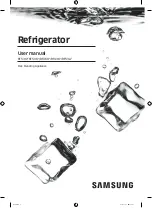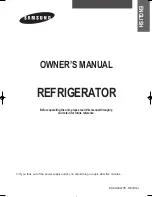
8
Operating Instructions
FOOD STORAGE
Refrigerator Compartment
•
To reduce humidity and avoid the consequent formation of frost, always store liquids in sealed containers in the
refrigerator. Frost tends to concentrate in the coldest parts of the evaporating liquid and, in time, your appliance
will require more frequent defrosting.
•
Cooked dishes must remain covered when they are kept in the fridge. Do not place warm foods in fridge.
Place
them when they are cool, otherwise the temperature/humidity inside the fridge will increases, reducing the fridge’s
efficiency.
•
Make sure no items are in direct contact with the rear wall of the appliance as frost will develop and packaging
will stick to it. Do not open the refrigerator door frequently.
•
We recommend that meat and clean fish are loosely wrapped and stored on the glass shelf just above the
vegetable bin where the air is cooler, as this provides the best storage conditions.
•
Store loose fruit and vegetable items in the crisper containers.
•
Storing fruit and vegetables separately helps prevent ethylene-sensitive vegetables (green leaves, broccoli,
carrot, etc.) being affected by ethylene- releaser fruits (banana, peach, apricot, fig etc.).
•
Do not put wet vegetables into the refrigerator.
•
Storage time for all food products depends on the initial quality of the food and an uninterrupted refrigeration
cycle before refrigerator storage.
•
Water leaking from meat may contaminate other products in the refrigerator. You should package meat products
and clean any leakages on the shelves.
•
Do not put food in front of the air flow passage.
•
Consume packaged foods before the recommend expiry date.
Do not allow food to come into contact with the temperature sensor, which is located in the refrigerated
compartment, in order to keep the refrigerator compartment at optimum temperature.
•
For normal working conditions, it will be sufficient to adjust the temperature setting of your refrigerator to +4 °C.
•
The temperature of the fridge compartment should be in the range of 0-8 °C, fresh foods below 0 °C are
iced and rotted, bacterial load increases above 8 °C, and spoils.
•
Do not put hot food in the refrigerator immediately, wait for the temperature to pass outside. Hot foods increase
the degree of your refrigerator and cause
food poisoning and unnecessary spoiling of the food.
•
Meat, fish, etc. should be store in the chiller compartment of the food, and the vegetable compartment is
preferred for vegetables. (if available)
•
To prevent cross contamination, meat products and fruit vegetables are not stored together.
•
Foods should be placed in the refrigerator in closed containers or covered to prevent moisture and odors.
Summary of Contents for OBMF243FI
Page 1: ...Instruction Manual FRIDGE OBMF243FI...
Page 6: ...3 Installation Instructions...
Page 7: ...4 Installation Instructions Note Refer to built in instruction...
Page 16: ...13 Built In Instructions...
Page 17: ...14 Built In Instructions...
Page 18: ...15 Built In Instructions...
Page 19: ...16 Built In Instructions...
Page 20: ...17 Built In Instructions...
Page 22: ...1...








































